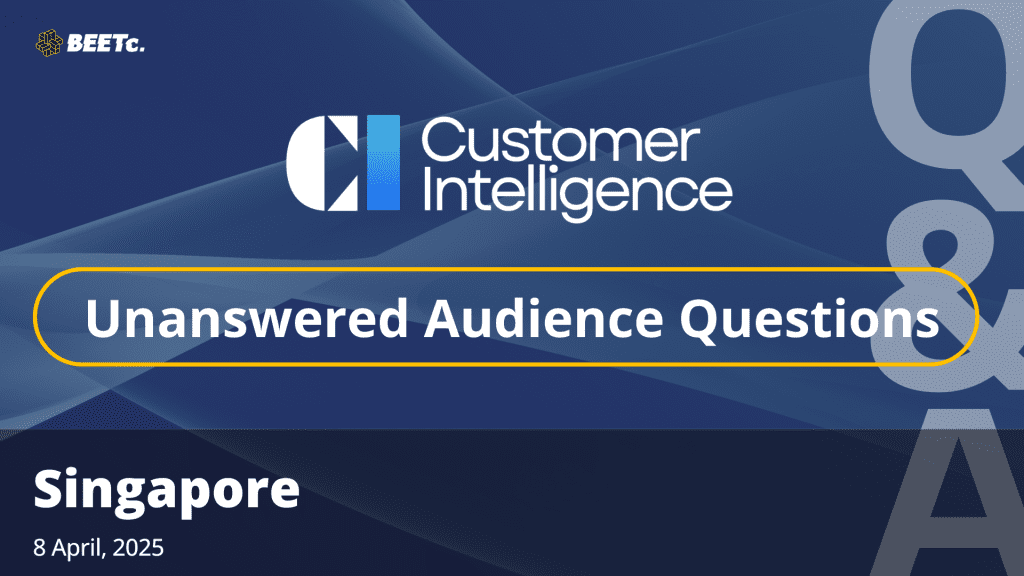
Welcome George Neo, Partnership Lead, Meta sharing his insights on Emerging Technologies, AI, AR/VR, Metaverse marketing, and more as part of the MarTech Thoughts series.
How do you describe your job to a 5-year-old?
A Partnerships team at Meta is like a superhero who helps other companies and organizations use Meta’s technology to build amazing things.
Imagine you have a toy box full of different toys, and each toy has a special power. The Partnerships team helps other people understand how to use those toys in the best way possible, so they can build incredible solutions that make people happy.
For example, if a start-up wants to use Meta’s virtual reality technology to create a new game, a Partnerships team would show them how to do it in a way that’s fun and easy for everyone. They might also help them come up with creative ideas for using Meta’s technology to solve problems or make people’s lives better.
So, being part of a Partnerships team at Meta is all about helping others use our super cool toys to build amazing things!
What is the one marketing platform/app/solution you can’t live without? Why?
Salesforces CRM – Salesforce CRM is critical to my role in sales and marketing due to its comprehensive features. It provides a unified platform for managing customer relationships, sales processes, and marketing campaigns, Salesforce empowers teams with actionable insights and data-driven strategies for better decision-making.
What would your company use AI the most for?
Meta provides advanced AI technology (Llama 3.1) to enhance its products and services, making them more efficient and accessible while fostering a vibrant community of AI enthusiasts and professionals.
What will be the next evolution in marketing technology that we can expect in the coming years?
AI has numerous applications in marketing, transforming the way businesses connect with their customers and drive growth. Some key use cases for AI in marketing include:
1) Personalization: AI enables personalized marketing by analysing customer data, behaviour, and preferences to create tailored messages, offers, and experiences that resonate with individual customers.
2) Predictive Analytics: AI-powered predictive analytics helps marketers forecast customer behaviour, identify trends, and make data-driven decisions to optimize campaigns and improve ROI.
3) Content Generation: AI can generate high-quality content, such as blog posts, social media posts, and ad copy, at scale and speed, freeing up human marketers to focus on creative strategy.
4) Chatbots and Virtual Assistants: AI-powered chatbots and virtual assistants provide 24/7 customer support, answer frequently asked questions, and help customers navigate complex product offerings.
5) Image and Video Analysis: AI can analyze images and videos to understand visual content, detect emotions, and track brand mentions, enabling marketers to optimize visual content and measure its impact.
6) Social Media Monitoring: AI-powered social media monitoring tools track brand mentions, sentiment, and conversations in real-time, helping marketers respond promptly to customer concerns and capitalize on trends.
What are the key challenges when implementing new technologies or platforms for the first time in your company, and do you have any suggestions for making the process smoother?
Companies may face several challenges when using AI, including:
1) Data Quality and Availability: AI models require high-quality and relevant data to learn and make accurate predictions. Companies may struggle to obtain, clean, and preprocess the necessary data.
2) Explainability and Transparency: As AI models become more complex, it can be difficult to understand how they arrive at their decisions, leading to concerns about bias, fairness, and accountability.
3) Ethical Considerations: AI raises ethical concerns, such as privacy, security, and potential biases in decision-making. Companies must ensure that their AI systems are designed and deployed ethically.
4) Integration with Existing Systems: Integrating AI into existing systems and processes can be challenging, requiring significant investments in infrastructure, training, and change management.
5) Talent and Expertise: Companies may need to hire or train staff with specialized skills in AI, machine learning, and data science to develop and maintain AI systems.
6) Regulatory Compliance: Companies must comply with regulations and laws related to AI, such as data privacy and security, which can be complex and time-consuming.
To make the AI adoption process smoother, consider the following suggestions:
1) Start Small: Begin with a pilot project or a limited scope to test and refine your AI implementation before scaling up.
2) Develop a Clear Strategy: Define a clear AI strategy, outlining goals, objectives, and expected outcomes to guide decision-making and resource allocation.
3) Invest in Data Preparation: Ensure high-quality data is available for AI model training and deployment by investing in data cleaning, preprocessing, and normalization.
4) Choose Appropriate AI Tools: Select AI tools and platforms that align with your company’s needs, skills, and infrastructure to minimize integration challenges.
5) Provide Training and Education: Offer training and education programs for employees to develop the necessary skills and understanding of AI concepts, tools, and applications.
6) Address Ethical Concerns: Establish guidelines and protocols for ethical AI development and deployment, addressing concerns around bias, privacy, and transparency.
7) Foster a Culture of Innovation: Encourage experimentation, learning, and innovation within your organization to drive AI adoption and continuous improvement.
8) Partner with Experts: Collaborate with external experts, consultants, or partners to supplement internal capabilities and accelerate AI adoption.
What is the scope of using AI and machine learning in Marketing Mix Modelling?
The scope of using AI and machine learning in Marketing Mix Modelling (MMM) is vast and rapidly expanding. MMM is a statistical analysis technique that aims to understand the relationship between marketing activities and business outcomes, such as sales, revenue, or market share.
Traditionally, MMM has relied on regression analysis and other statistical techniques to estimate the impact of various marketing mix elements, such as price, promotion, advertising, and distribution, on sales and other business outcomes. However, with the advent of AI and machine learning, MMM can now leverage more advanced algorithms and techniques to improve its accuracy, speed, and scalability.
What is the most effective use of technology you’ve seen in navigating today’s rapidly changing and diverse world?
I’ve seen many effective uses of technology in navigating today’s rapidly changing and diverse world. However, one that stands out to me is the use of virtual reality (VR) and augmented reality (AR) technologies to promote empathy and understanding across cultures.
VR and AR have the power to transport people to different environments and experiences, allowing them to walk in someone else’s shoes and gain a deeper understanding of their perspectives. This can be particularly powerful in breaking down cultural and social barriers, promoting tolerance, and fostering global citizenship.
For example, I’ve seen VR experiences that allow people to explore refugee camps, experience the daily life of a person with a disability, or understand the impact of climate change on vulnerable communities. These experiences can be incredibly moving and transformative, helping to build bridges between people from different backgrounds and foster a sense of shared humanity.
Another effective use of technology I’ve seen is the use of artificial intelligence (AI) and machine learning (ML) to address social and environmental challenges. For instance, AI-powered systems can help analyse large amounts of data to identify patterns and trends related to climate change, poverty, or inequality. This can inform evidence-based decision-making and drive more effective solutions to these pressing issues.
Additionally, AI-powered chatbots and virtual assistants can provide critical support to marginalized communities, such as refugees, women, and minorities, by offering access to vital information, resources, and services.
Overall, I believe that technology has the potential to be a powerful force for good, but it’s important to ensure that its development and deployment are guided by ethical principles and a commitment to promoting equity, inclusivity, and social justice.
How could a marketer start utilising the Metaverse?
As a marketer, you can start utilizing the Metaverse by exploring its various aspects and identifying opportunities that align with your marketing goals. Here are some steps to get you started:
1) Understand the Metaverse: Familiarize yourself with the concept of the Metaverse, its history, and its current state. Learn about the different platforms, technologies, and communities that make up the Metaverse.
2) Identify your target audience: Determine if your target audience is already present in the Metaverse or if there’s an opportunity to reach new customers within this space.
3) Create a presence: Establish a presence within the chosen platform, such as a virtual storefront, event space, or interactive experience.
4) Develop engaging content: Create immersive and interactive content that resonates with your target audience. This could include 3D models, virtual events, or interactive games.
5) Leverage social media: Utilize social media channels to promote your Metaverse presence and drive traffic to your virtual experiences.
6) Collaborate with influencers: Partner with Metaverse influencers or content creators to amplify your brand’s message and reach a wider audience.
7) Monitor and measure performance: Track key performance indicators (KPIs) such as engagement, conversion rates, and return on investment (ROI) to evaluate the effectiveness of your Metaverse marketing efforts.
8) Stay up-to-date: Continuously educate yourself on the latest Metaverse trends, technologies, and best practices to ensure your marketing strategies remain relevant and effective.
The Metaverse is still evolving, and it’s essential to be flexible and adapt to changes as they occur. By being an early adopter and experimenting with different strategies, you can establish your brand as a pioneer in this emerging space.
With the advancement of AR & VR, how do you see these being utilised in Digital Storytelling?
The advancement of AR & VR technologies has the potential to revolutionize digital storytelling by providing new and immersive ways to engage audiences. Here are some ways I see AR & VR being utilized in digital storytelling:
1) Immersive experiences: AR & VR can transport audiences into the story, allowing them to experience it from within. This can create a deeper emotional connection with the characters and the narrative.
2) Interactive narratives: AR & VR enable interactive elements that allow audiences to influence the story or its outcome. This can lead to more personalized and engaging experiences.
3) Virtual reality field trips: AR & VR can take students on virtual field trips to historical sites, museums, or other places they may not be able to visit in person. This can enhance their learning experience and make it more memorable.
4) Augmented reality filters: AR filters can be used to add interactive elements to videos, such as pop-up facts, quizzes, or games. This can make educational content more engaging and fun.
5) Virtual reality training simulations: AR & VR can be used to create realistic training simulations for industries like healthcare, aviation, or the military. This can improve training outcomes and reduce costs.
6) Storytelling through data visualization: AR & VR can be used to visualize complex data in an engaging and interactive way. This can help audiences understand complex issues and make informed decisions.
7) Accessibility: AR & VR can provide equal access to education and entertainment for people with disabilities. For example, VR can provide a sense of presence and immersion for people who are visually impaired.
8) Social impact: AR & VR can raise awareness about social and environmental issues by providing an immersive and empathetic experience. This can inspire audiences to take action and make a positive impact.
9) Gaming: AR & VR can revolutionize the gaming industry by providing immersive and interactive experiences that blur the lines between reality and fantasy.
10) Film and television: AR & VR can change the way we consume film and television by providing immersive and interactive experiences that put the audience in the midst of the action.
These are just a few examples of how AR & VR can be utilized in digital storytelling. As the technology continues to evolve, we can expect to see even more innovative applications in the future.
What is your strategy to link up traditional and modern trade ecosystem?
My strategy to link up traditional and modern trade ecosystems involves several key steps:
1) Understand the traditional trade ecosystem: I would start by gaining a deep understanding of the traditional trade ecosystem, including its strengths, weaknesses, and pain points. This would involve researching the industry, talking to stakeholders, and analysing data.
2) Identify areas for modernization: Based on research, I would identify areas where modern technology can be leveraged to improve efficiency, reduce costs, and enhance customer experience. This could include implementing digital platforms for ordering, inventory management, and logistics, or using data analytics to optimize supply chain operations.
3) Develop a digital transformation roadmap: I would create a comprehensive roadmap that outlines the steps necessary to modernize the traditional trade ecosystem. This would include timelines, milestones, and key performance indicators (KPIs) to measure progress.
4) Build partnerships with modern trade players: I would establish partnerships with modern trade players, such as e-commerce platforms, logistics providers, and payment gateways, to leverage their expertise and resources. This would enable the traditional trade ecosystem to tap into new markets, technologies, and customer bases.
5) Implement digital solutions: I would work with the traditional trade ecosystem to implement digital solutions that address specific pain points and improve operational efficiency. This could include developing mobile apps for customers, implementing digital payment systems, or using artificial intelligence (AI) to optimize inventory management.
6) Train and upskill the workforce: I would provide training and upskilling programs for the workforce to ensure they have the necessary skills to operate in a modern trade ecosystem. This could include training on digital tools, data analysis, and customer service.
What’s the best advice someone has ever given you?
Simplified! – Simplifying complex ideas or concepts can help to make them more clear and easier to understand. By breaking down complex information into smaller, more manageable parts, it becomes easier to comprehend and communicate
A big thank you to George Neo, Partnership Lead, Meta sharing his insights on Emerging Technologies, AI, AR/VR, Metaverse marketing. If you want to connect with George, feel free to reach out via LinkedIn!
See more MarTech Thoughts interview pieces here!
Last updated: August 2024













